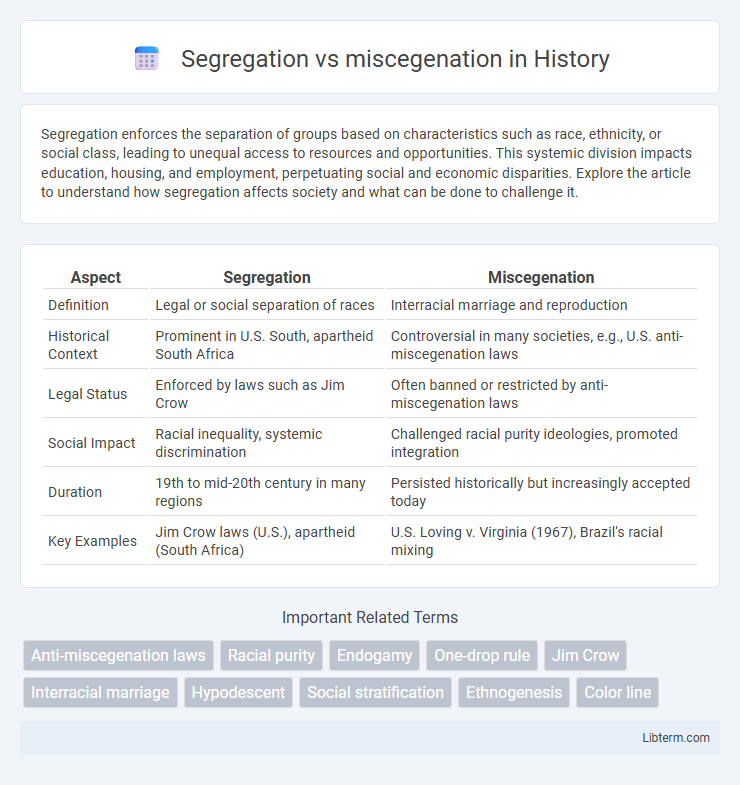Segregation enforces the separation of groups based on characteristics such as race, ethnicity, or social class, leading to unequal access to resources and opportunities. This systemic division impacts education, housing, and employment, perpetuating social and economic disparities. Explore the article to understand how segregation affects society and what can be done to challenge it.
Table of Comparison
| Aspect | Segregation | Miscegenation |
|---|---|---|
| Definition | Legal or social separation of races | Interracial marriage and reproduction |
| Historical Context | Prominent in U.S. South, apartheid South Africa | Controversial in many societies, e.g., U.S. anti-miscegenation laws |
| Legal Status | Enforced by laws such as Jim Crow | Often banned or restricted by anti-miscegenation laws |
| Social Impact | Racial inequality, systemic discrimination | Challenged racial purity ideologies, promoted integration |
| Duration | 19th to mid-20th century in many regions | Persisted historically but increasingly accepted today |
| Key Examples | Jim Crow laws (U.S.), apartheid (South Africa) | U.S. Loving v. Virginia (1967), Brazil's racial mixing |
Introduction to Segregation and Miscegenation
Segregation refers to the systemic separation of people based on racial, ethnic, or social groupings, often enforced through laws, policies, or social norms to maintain unequal power dynamics. Miscegenation, on the other hand, involves the interbreeding or marriage between individuals of different racial or ethnic backgrounds, challenging traditional racial boundaries and social segregation. The historical and social implications of both concepts reveal contrasting approaches to race relations, reflecting societal attitudes toward diversity and integration.
Historical Context of Segregation
Segregation in historical context primarily refers to the enforced separation of racial groups, particularly under laws and policies in the United States from the late 19th century through the mid-20th century. The Jim Crow laws institutionalized segregation in public facilities, education, transportation, and housing, entrenching racial inequality and social stratification. This systemic division sharply contrasted with miscegenation, which involved interracial relationships and marriage, often criminalized and stigmatized during the same period.
The Origins and Impact of Miscegenation Laws
Miscegenation laws originated primarily in the United States during the colonial and antebellum periods, rooted in racial ideologies that aimed to maintain white supremacy by prohibiting interracial marriages and relationships. These laws reinforced social hierarchies and institutionalized racial segregation by legally criminalizing racial mixing, thereby shaping demographic patterns and family structures. The impact of miscegenation laws persisted well into the 20th century, affecting civil rights movements and contributing to the ongoing struggle against systemic racism and discrimination in society.
Cultural Narratives: Segregation vs Miscegenation
Cultural narratives surrounding segregation emphasize division, maintaining racial boundaries to preserve perceived purity and social order, often justified by pseudoscience and discriminatory ideologies. In contrast, narratives supporting miscegenation highlight the blending of cultures and races as a path toward social progress, unity, and the breakdown of oppressive hierarchies. Both narratives shape societal attitudes, influencing policies and personal identities within multicultural societies.
Legal Frameworks and Landmark Court Cases
Legal frameworks surrounding segregation and miscegenation have evolved through landmark court cases that challenged racial discrimination in marriage and public facilities. The 1954 Supreme Court decision in Brown v. Board of Education declared segregation in public schools unconstitutional, setting a precedent for civil rights advancements. Loving v. Virginia (1967) struck down laws banning interracial marriage, affirming marriage as a fundamental right and dismantling remaining legal barriers to miscegenation.
Societal Consequences and Racial Identity
Segregation reinforces racial divisions by limiting interaction and perpetuating stereotypes, leading to deep social inequalities and weakened community cohesion. Miscegenation challenges rigid racial boundaries, promoting multicultural identities and fostering social integration, but can also provoke backlash from groups invested in preserving racial purity. The societal consequences of these opposing forces shape racial identity by either entrenching separatism or encouraging hybridized, fluid concepts of self within diverse populations.
Political Motivations Behind Segregation Policies
Segregation policies were driven by political motivations aimed at maintaining white supremacy and controlling minority populations through legal and institutional means. Lawmakers enacted segregation to reinforce racial hierarchies, prevent social integration, and secure political power by appealing to the racial fears of the majority electorate. These policies were instrumental in shaping voting laws, education systems, and public services to sustain systemic inequality and marginalize minority communities.
Resistance Movements and Integration Efforts
Resistance movements against segregation included organizations like the NAACP and leaders such as Martin Luther King Jr., who advocated for civil rights through nonviolent protests and legal challenges. Efforts to promote integration involved landmark cases like Brown v. Board of Education, which declared school segregation unconstitutional and fueled desegregation policies. Community initiatives, grassroots activism, and federal legislation such as the Civil Rights Act of 1964 played crucial roles in dismantling institutional segregation and fostering social integration.
Contemporary Perspectives and Ongoing Challenges
Contemporary perspectives on segregation and miscegenation highlight the ongoing societal challenges related to racial integration and cultural acceptance. Despite progress in legal frameworks promoting diversity, systemic inequalities and social prejudices continue to hinder true inclusion and interracial relationships. Ongoing challenges include addressing implicit biases, combating institutional racism, and fostering environments that celebrate multicultural identities while dismantling segregationist legacies.
Conclusion: Towards Racial Equity and Inclusion
Achieving racial equity and inclusion requires dismantling systemic segregation while embracing the principles of miscegenation to foster diverse and integrated communities. Policies promoting equal access to housing, education, and employment can reduce racial divides and encourage social cohesion. Emphasizing shared humanity and cultural exchange lays the foundation for a more just and inclusive society.
Segregation Infographic

 libterm.com
libterm.com